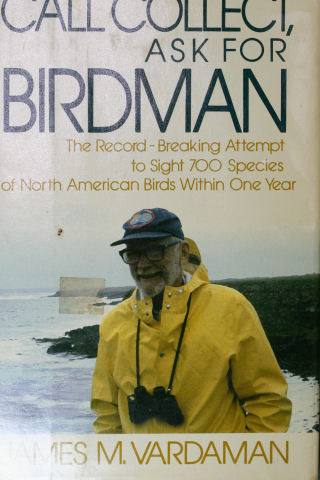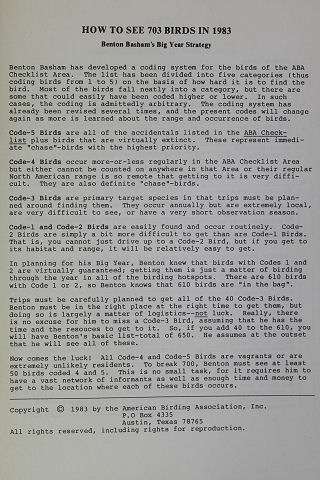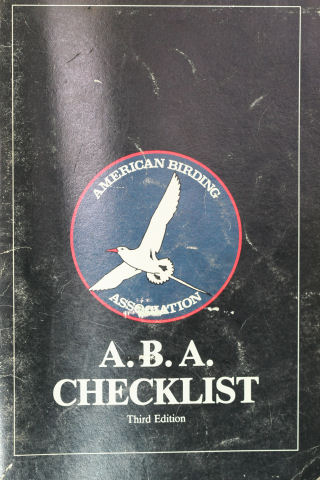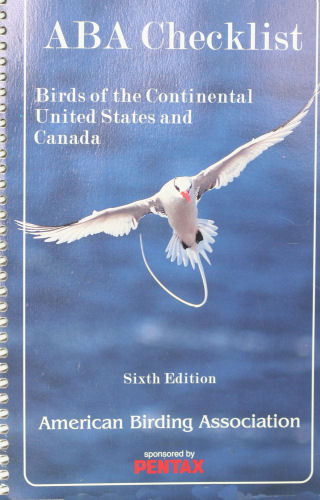When the Sixth Edtion of the ABA Checklist of Birds came out, I withdrew my support of the ABA. Here's the story.

In 1979, James Vardaman made the first attempt to see 700 species in one year. He missed by one. In 1983, Benton Basham attempted to break the 700 barrier in one year. Benton was a much better birder and better organized than Vardaman and he saw 703. (Of course, communication in the birding community had made quantum leaps in those few years and locating rarities was easier.)


In 1986, the American Birding Association incorporated Basham's coding system into its ABA Checklist (3rd Edition). In 1990, the ABA added Class 6 birds to include those which could not be seen: a) those not sighted in 100 years or more (Bachman's Warbler) and those which are extinct or extirpated in the ABA area (Great Auk) or b) all surviving members are held in captivity (California Condor). This change did not affect the over-all system and was unnecessary but did no harm.

Since 1986, the ABA Checklist Committee has changed the classifications of some birds to reflect recent discoveries from field reports, scientific research, and changes in informed opinion about the range and occurrence of birds. This was certainly appropriate.
In 1997, Jon Dunn over-hauled the classifications to reflect the actual abundance of the birds rather than ease of finding them. This new approach was introduced in the ABA Checklist (6th Edition, 2002) and has been retained to the present. Sadly, this change was fatal to the system.
Although Code 6 remains the same, code 5 birds are now "species recorded five or fewer times in the ABA area or fewer than three times in the last 30 years." Code 4 birds are "casual...not recorded annually...with three or more records in the last 30 years." Code 3 birds occur annually in very low numbers including visitors and rare breeding residents. There is no longer any meaningful distinction between Code 1 and Code 2 birds. The paragraph about Code 1 and 2 birds concludes "We readily acknowledge that some Code 2 species are harder to find than some species that have higher codes." What is not acknowleged is that there is now no difference in practical terms among Code 3, 4, and 5 birds. In any given year one's chances of seeing a bird in any of these classes is about the same! This new system has led to the absurdity of placing many former Codes 3 and 4 birds in the Code 2 group so a Himalayan Snowcock is now supposedly as easy to see as a Blue Grouse and a Bristle-thighed Curlew can be found as readily as a Bar-tailed Godwit. Is it really harder to see a Hook-billed Kite than a Snail Kite?
A similar problem exists in the revised Status designations. Prior to the Sixth Edition, the checklist classified the status of birds as Nesting, Introduced, Accidental, Visitor, and Extinct. The Sixth Edition classifies them as Native Breeding, Introduced, Visitor, and Extinct with the added fillip of "Species of Special Concern." The dropping of the Accidental Status makes it appear that a birder has an equal chance of seeing a Jabiru as a Western Reef Heron even though there is only one record ever of the latter and the former shows up every few years. The Status Designations have become so useless that they have been dropped completely from the Seventh Edition.
I am not sure what purpose the current system serves but I am sure that these Difficulty Code definitions seriously handicap birders who previously used these codes to evaluate the likelihood of seeing a given species on a given birding trip. The codes no longer have any relationship to the realities of bird "see-ability" and are useless for planning field birding. Isn't it ironic that an organization founded to assist and encourage field birding should have so degraded one of its most valuable tools?